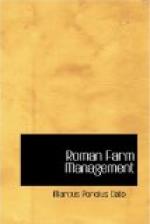(CLX) If a bone is dislocated it can be made sound by this incantation. Take a green reed four or five feet long, split it down the middle and let two men hold the pieces against your hips. Begin then to chant as follows:
“In Alio. S.F. Motas Vaeta,
Daries Dardaries Astataries Dissunapiter”
and continue until the free ends of the reed are brought slowly together in front of you. Meanwhile, wave a knife above the reeds, and when they come together and one touches the other, seize them in your hand and cut them right and left. These pieces of reed bound upon a dislocated or fractured bone will cure it.[38]
But every day repeat the incantation, or in place of it this one:
“Huat Hanat Huat
Ista Pista Sista
Domiabo Damnaustra"[39]
Of cakes and salad[40]
(LXXV) This is the recipe for cheese cake (libum): Bray well two pounds of cheese in a mortar, and, when this is done, pour in a pound of corn meal (or, if you want to be more dainty, a half pound of flour) and mix it thoroughly with the cheese. Add one egg and beat it well. Pat into a cake, place it on leaves and bake slowly on a hot hearth stone under a dish.
(CXIX) This is the recipe for olive salad (epityrum): Select some white, black and mottled olives and stone them. Mix and cut them up. Add a dressing of oil, vinegar, coriander, cumin, fennel, rue and mint. Mix well in an earthen ware dish, and serve with oil.
(CXXI) This is the recipe for must cake (mustaceus): Sprinkle a peck of wheat flour with must. Add anise, cumin, two pounds of lard, a pound of cheese and shredded laurel twigs. When you have kneaded the dough, put laurel leaves under it and so bake.
Of curing hams
(CLXII) This is the way to cure hams in jars or tubs: When you have bought your hams trim off the hocks. Take a half peck (semodius) of ground Roman salt for each ham. Cover the bottom of the jar or tub with salt and put in a ham, skin down. Cover the whole with salt and put another ham on top, and cover this in the same manner. Be careful that meat does not touch meat. So proceed, and when you have packed all the hams, cover the top with salt so that no meat can be seen, and smooth it out even. When the hams have been in salt five days, take them all out with the salt and repack them, putting those which were on top at the bottom. Cover them in the same way with salt and press them down.
After the twelfth day remove the hams finally, brush off the salt and hang them for two days in the wind. On the third day wipe them off clean with a sponge and rub them with (olive) oil. Then hang them in smoke for two days, and on the third day rub them with a mixture of (olive) oil and vinegar.
Then hang them in the meat house, and neither bats nor worms will touch them.[41]




